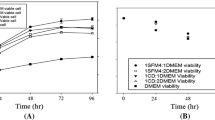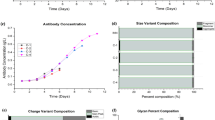Abstract
Taguchi’s methods were used for the design of an experimental strategy aimed at optimizing cell density and monoclonal antibody (mAb) production from a spinner flask hybridoma culture. 23G11 is an antibody to the human leukocyte adhesion molecule, CR3 or β 2 integrin (CD11b/CD18). It recognizes specifically the A-domain of the α subunit CD11b. Anti β 2 integrin monoclonal antibodies hold a great potential for preventing inflammation mediated tissue injuries. An L8 orthogonal experimental design was used to investigate four different culture components: stirring speed, nature of serum, concentration of serum and nature of media (RPMI 1640 or RPMI 1640 supplemented with glucose and glutamine). The experiments were conducted using two levels for each factor studied and a direct ELISA test was used to estimate the level of antibody production. Statistical analysis of the collected data pointed to the stirring speed and serum concentration, and the interaction between these parameters, as the components that affected cell growth. Antibody production was affected by these factors and by the nature of medium but also by the following two interactions: stirring speed/nature of serum and stirring speed/concentration of serum. This study emphasizes the value of using Taguchi’s methods as a basis for optimization of mAb production from a hybridoma culture, in cost effective and significantly less labor intensive ways.
Similar content being viewed by others
References
Aujame L., Seguin D., Droy C. and Hessler C. 2000. Experimental design optimisation of filamentous phage transfect mammalian cells by cationic lipids. Biotechniques 28: 1202-1208
Burch G.J., Ferguson C.H., Cartwright G. and Kwong F.Y. 1995. Application of Taguchi experimental design to the optimization of baculovirus expression system. Biochem. Soc. Trans. 23: 107S.
Cobb B.D. and Clarkson J.M. 1994. A simple procedure for optimizing the polymerase chain reaction (PCR) using modified Taguchi methods. Nucleic. Acids Res. 22: 3801-3805.
Dhir S., Morrow K. Jr., Rhinehart R.R. and Wiesner T. 2000. Dynamic optimization of hybridoma growth in a Fed-Batch Bioreactor. Biotechnol. Bioeng. 67: 197-205.
Fielder U. and Conrad U. 1995. High-level production and long term storage of engineered antibodies in transgenic tobacco seeds. Bio/Technology. 13:1090-1093.
Goosen M.F.A. 1993. Insect culture engineering: an overview. In: Goosen M.F.A., Baugulis A. and Faulkner(eds), Insect Cell Culture Engineering. Marcel Dekker, New York, pp. 1-16.
Han J.J., Yang T.H. and Rhee J.S. 1998. Optimization of reaction variables for sucrose monoester production using lipase in a solvent free system by Taguchi's method. Biotechnol. Techniques 12: 295-299.
Harlow E. and Lane D. 1988. Antibodies: A Laboratory Manual. Cold Spring Harbor Laboratory, Boston. 274-277.
Jeney C., Dobay O., Lengyel A., Adam E. and Nasz I. 1999. Taguchi optimization of ELISA procedures. J. Immunol. Methods 223: 137-146.
Kurkela R., Fraune E. and Vihko P. 1993. Pilot-scale production of murine monoclonal antibodies in agitated, ceramic-matrix or hollow-fiber cell culture systems. Biotechniques 15: 674-683.
Laroche-Traineau J., Clofent-Sanchez G. and Santarelli X. 2000. Three-step purification of bacterially expressed human single-chain Fv antibodies for clinical applications. J. Chromatogr. B. Biomed. Sci. Appl. 14: 107-117.
Maier S.T., Buchhioz R. and Marx U. 1995. Influence of glucose, glutamine and oxygen on the metabolism of hybridomas and peripheral blood cells. In: Spier R.E., Griffiths J.B. and Beuvery E.C. (eds), Animal Cell Technology: Developments Towards the 21stCentury. Kluwer Academic Publishers, Dordrecht, pp. 235-239.
Merten O.-W. 1989. Culture of hybridoma-a survey. In: Miller A.O.A. (ed.), Advanced Research on Animal Cell Technology. Kluwer Academic Publishers, Dordrecht, pp. 367-400.
Miller W.M., Blanch H.W. and Wilke C.R. 1988. A kinetic analysis of hybridoma growth and metabolism in batch and continuous suspension culture: effect of nutrient concentration, dilution rate and pH. Biotechnol. Bioeng. 32: 947-965.
Oyaas K., Ellingsen T.E., Dyrset N. and Levine D.W. 1994. Hyperosmotic hybridoma cell cultures: increased monoclonal production with addition of glycine betaine. Biotechnol. Bioeng. 42: 601-610.
Sanfeliu A., Cairo J.J., Casas C., Sola C. and Godia F. 1995. the effect of medium composition on growth and monoclonal antibody production of hybridoma cells. In: Spier R.E., Griffiths J.B. and Beuvery E.C. (eds), Animal Cell Technology: Developments Towards the 21st Century. Kluwer Academic Publishers, Dordrecht, pp. 307-312.
Taguchi G. 1986. Introduction to Quality Engineering. Asian Productivity Organization. UNIPUB, New York.
Yang J.D., Angelillo Y., Chaudhry M., Goldenberg D.M. and Glodenberg D.M. 2000. Achievement of high cell density and high antibody productivity by a controlled-fed perfusion bioreactor process. Biotechnol. Bioeng. 69: 74-82.
Author information
Authors and Affiliations
Rights and permissions
About this article
Cite this article
Kallel, H., Zaïri, H., Rourou, S. et al. Use of Taguchi's methods as a basis to optimize hybridoma cell line growth and antibody production in a spinner flask. Cytotechnology 39, 9–14 (2002). https://doi.org/10.1023/A:1022437514334
Issue Date:
DOI: https://doi.org/10.1023/A:1022437514334




